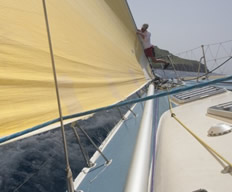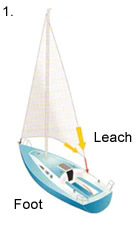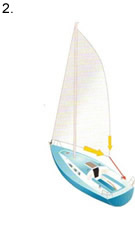
Trim and shapely - genoas
Genoa trim is of particular importance when the wind is forward of the beam.
Genoa trim is of particular importance when the wind is forward of the beam and wind is passing over the genoa before the mainsail.
An incorrectly sheeted genoa can wrongly direct wind over the mainsail making it unhappy too. The tools to adjust shape in a genoa are halyard tension, mast rake, backstay tension, genoa car positioning and sheet tension.
We'll start by looking at genoa cars and sheet tension as these are the easiest to adjust.
Cars
Most genoa cars move forward and backwards on tracks either side of the deck. By moving the cars, the sheeting angle of the genoa is altered changing the tension in the leach and foot and altering the shape of the sail.
The intention is to get an even tension on the foot and the leach.
 |
1.Car too far forward; the foot of the sail sags, the leach will be pulled down tight almost straight. |
 |
2.Car too far aft; the foot is pulled tight, but the leach will lift causing the top of the sail to twist excessively and flap. |
 |
3.Car somewhere in the middle should give an even tension in the foot and the leach allowing good trim. A general rule of thumb is to move the car forward until the top of the leach just stops fluttering. |
|
4.On furling headsails, the genoa cars usually require moving forward as the sail is furled to keep the correct sail shape. |
 |
Twist
Don't be surprised if the top of the leach twists out to leeward more than at the bottom – it's supposed to. Wind speed increases and frees a little with height.
Therefore the top of the sail is trimmed freer than the base of the sail. The amount of twist is judged by looking up the leach to see if the top of the sail is flapping more than the central sections.
A more precise method is comparing the telltales along the luff from tack to the head.
Telltales
Telltales give a clearer picture of the airflow passing over both sides of the sail.
On a genoa it is useful to have three sets of telltales along the luff; at the top, middle and about a metre up from the tack. Telltales flow straight if the sail is well trimmed
In the following illustrations the leeward (outside) telltales are green and the windward (inside) telltales are red.
Tell tales and sheet adjustment
 |
If the windward (inside) telltales flutter – bear away or sheet in. |
 |
If the leeward (outside) telltales flutter – head up or ease sheets. |
Telltales and car adjustment
|
1.Telltales all streaming nicely with the windward ones just starting to lift – perfect, the air flow is constant all the way up the sail. |
|
|
2.Just the top windward telltale lifting whilst the bottom one is fine, sheeting-in would only spoil the air flow over the bottom of the sail. The problem is too much twist at the top of the sail - move the genoa car forward to increase the downward pressure on the leach. |
|
|
3.Top leeward telltale lifting indicating the leach is too tight and too little twist, ease the car back slightly to open the leach. The lower windward telltale lifting would indicate a similar problem. |
|
Simon Jinks, RYA Yachtmaster™ Instructor Examiner and Journalist
Illustrations: RYA Sail Trim Handbook by Rob Gibson
Contact UsArticle Published: April 27, 2011 14:32
Article Updated: April 29, 2013 11:45